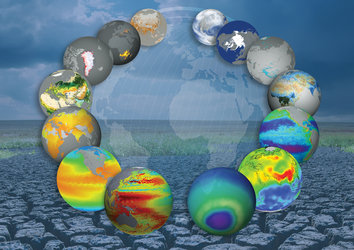Satellites and climate tipping points
The effects of our warming climate are seen across a multitude of measures, usually as incremental changes: more frequent extreme weather, heatwaves, droughts and wildfires. The cumulative impact of these changes, however, can cause fundamental parts of the Earth system to change more quickly and drastically. These ‘tipping points’ are thresholds where a tiny change pushes the system into an entirely new state.
This week, at ESA’s Living Planet Symposium, scientists came together to discuss the latest research evidence for climate tipping points and identify the opportunities and challenges of using remote sensing data to understand them.
Tipping points are typically self-propelling, so that, once triggered, they drive deeper change. Examples include strongly increased ice sheet melt, permafrost thaw, ocean circulation changes and forest dieback. The threat to society from climate tipping points – both individually and due to their interactions – is not yet well understood. It is an area needing urgent research to develop predictions of when and where these abrupt changes can occur and the risk that they pose to communities and ecosystems worldwide.
The global view and high spatial resolution afforded by satellites pose a particularly useful opportunity, said researchers at ESA’s Living Planet Symposium in Bonn, Germany. Remote sensing has already been used to provide critical evidence of the proximity of several tipping elements, ranging from ice sheets to boreal and tropical forests.
“Successive IPCC Assessment Reports have revised upwards the risks posed by climate tipping points,” says Tim Lenton, from the University of Exeter.
“Tipping points have already informed climate mitigation targets, including the Paris Agreement’s goal to limit warming to well below two degrees Celsius. If the risk of tipping is still underestimated, it would provide a reason to strengthen such pledges and action to meet them. That’s why it’s so important to understand the proximity of tipping points and their impact on society.”

The recently published IPCC sixth climate Assessment Report warns that high impact climate tipping points at regional scales cannot be ruled out. The risk of crossing thresholds into more abrupt changes increases at higher levels of global warming.
Human activities can also be a factor: for example, continued deforestation of the Amazon along with a warming climate are together making it more likely that the forest will tip into a savannah state before 2100.
“Climate tipping points are a new and growing area of research that is critical for developing early warning systems to inform policy and action going forward,” says Wendy Broadgate, Director of Future Earth’s Sweden hub who chaired the discussion. Future Earth hosts the Earth Commission, which uses a tipping points analysis to quantify the parameters to maintain a safe and resilient Earth system, which feeds into work with cities, businesses and nations for target-setting.
“Researchers have been making progress on resilience indicators in conceptual models as well as models of Arctic sea ice, ice sheets, the Atlantic Meridional Overturning Circulation and other potential Tipping Elements,” said keynote speaker Sebastian Bathiany from Technical University of Munich. But models can only go so far in improving our understanding of how and when abrupt change will occur.
“In order to understand what is going on in the real world, we need to work toward a meaningful interpretation of resilience indicators in Earth observation records. This is why discussions across scientific communities and disciplines are so important."

Didier Swingedouw, who is based at the University of Bordeaux, explains, “We have moderate confidence that ocean circulation in the North Atlantic will not collapse during this century because climate models still miss key processes.”
To gain a better understanding of ocean dynamics and therefore make more reliable predictions of any potential rapid changes, the models should be better coupled to Earth observation datasets. He says, “A rapid weakening of the Atlantic Meridional Overturning Circulation would have worldwide impacts: it is therefore urgent to work on the risk of such an event occurring.”
Today’s discussion follows on from an ESA workshop held in 2021 that considered how Earth observations can be used for monitoring and early warning of tipping points, hosted by the International Space Science Institute with the Future Earth ‘AIMES’ project and the World Climate Research Programme.
Key areas under discussion included how to develop systems for early warning of tipping onset and using remote sensing to examine the interactions between tipping elements.
The Living Planet Symposium has attracted thousands of scientists and data users, and is amongst the biggest Earth observation conferences in the world. The event not only sees scientists present their latest findings on Earth’s environment and climate derived from satellite data, but also focuses on Earth observation’s role in building a sustainable future and a resilient society.















 Germany
Germany
 Austria
Austria
 Belgium
Belgium
 Denmark
Denmark
 Spain
Spain
 Estonia
Estonia
 Finland
Finland
 France
France
 Greece
Greece
 Hungary
Hungary
 Ireland
Ireland
 Italy
Italy
 Luxembourg
Luxembourg
 Norway
Norway
 The Netherlands
The Netherlands
 Poland
Poland
 Portugal
Portugal
 Czechia
Czechia
 Romania
Romania
 United Kingdom
United Kingdom
 Slovenia
Slovenia
 Sweden
Sweden
 Switzerland
Switzerland

































